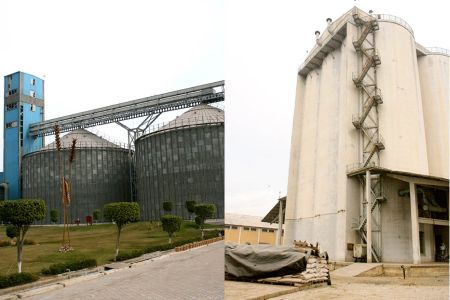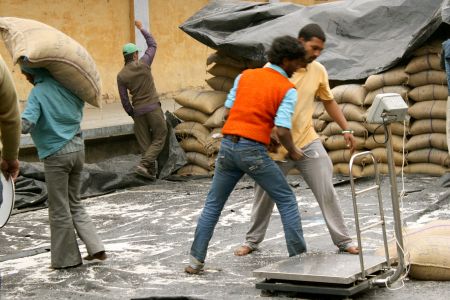by Trent Houdek and Eddy Salinas, Juniors in Supply Chain Management at the University of Illinois at Urbana-Champaign
The following post was written by students on an ADM Institute-sponsored observation study tour through India.

Left: Adani Facility, Right: FCI Facility Credit: ADM Institute/Kari Wozniak
Comparative analysis was the name of the game on one of our last days in India. While in the state of Punjab, a state often referred to as part of the “breadbasket of India”, we had the chance to view two storage facilities that serve growers in the Moga area. In comparing a newer facility operated by the Adani Logistics Limited (ALL), the result of a public-private partnership, and a government facility operated by the Food Corporation of India (FCI), we observed how different transportation, storage, and management methods either encourage or reduce postharvest loss.
We began the day at the ALL site, where the first comparison we drew stemmed from our own background knowledge of agriculture. As students at the University of Illinois, what most often comes to mind when we think of farms are seemingly endless stretches of corn and soybean fields that surround our Urbana campus. Where the average farm size in Illinois is 368 acres, however, none of the farmers we had met throughout our trip had plots greater than 5 acres of land. This different type of industry demographic impacts the way transportation functions in the paddy and wheat supply chains that we were studying in India.
Smallholder farmers have two options when it comes to selling their product to large-scale distributors – they can bag their own crop, or pool their crops with other farmers to transport their product in bulk. At the ALL site, we could see that bulk transport is the better option. When farmers individually bring their own bagged product to the facility, a special team is needed to open and remove all contents from the bags. This added human element increases the chance for error, or product loss, while increasing costs as extra labor is required.
But though bulk transportation to storage is ideal, the nature of agriculture in India makes it difficult to carry out. With such small farm sizes, proper infrastructure at the farm and village level is needed to support bulk transportation. Given a lack for this type of infrastructure, the reality is that facilities like ALL’s are still more likely to receive bagged product in smaller quantities.

Laborer uses claw-like tools to grip bags. Credit: ADM Institute/Kari Wozniak
Later in the day, we visited an FCI facility where we observed much different management procedures. The entire product at the facility was stored in bags, versus in large silos like at the ALL site. Some of the bags were stacked on pallets, left in the open air and covered loosely by large black tarps. Others were stacked in covered buildings, called godowns, where they typically will be kept for about a year. The common way to move this product is to use two hook-like tools that claw into the bags, a process that often takes multiple attempts to get the right grip (pictured above).
On that overcast day, the problems with loss were widely apparent. Black crows lingered around the stacks of bags, indicating there was spilled grain. There were holes in the roofs of the storage facilities that left the grain inside exposed to any potential effects of unexpected weather. As if to show us what could happen, unexpected rain did come, creating a huge scramble amongst the facility staff to cover the bags stored in the open air.
The ALL staff had showed us their quality control process, which includes substantial sampling and testing. At FCI, sampling was not performed as scientifically, and it also seemed to create additional loss. We observed how the staff pinched a narrow funnel-like tool into each bag to take a sample, which created dime-sized holes. While inside a godown, one staff member told us that quality checks were performed through manual observation.
While the transportation problem is an obstacle facing newer storage facilities such as ALL, the procedures and methods nonetheless remain improvements to what we observed at the FCI facility. Being able to tour both facilities in one day was truly a unique opportunity. It allowed to us view several real-life supply chain problems at both the site and industry level, which was an invaluable experience to our study of supply chain management.
More about the trip:
- Illinois Students Gear up to Impact Global Food Security
- Following the Flowers: A First Look at Indian Supply Chains
- Losses Along the Way
- Taste of India
- Southern Indian Hospitality
- For Field and Family: A Woman’s Life Farming in Rural India
- Newer Facility Shows Efficient Grain Management in India is Possible, But Not Yet Justified
Edited by K. Wozniak/G. Kenney


No comments yet.